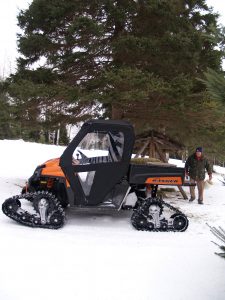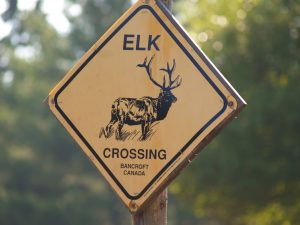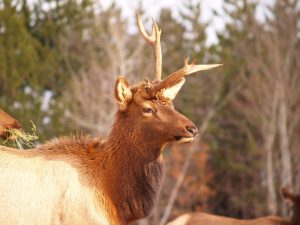
It’s shortly after 6 a.m. and we are into another deep freeze. Penning this in the comfort of my office my mind wanders thinking of Joe as he most certainly will be outdoors feeding the elk. Joe turned 86 on February 8, 2015. He has had both knees replaced and his shoulders are seizing up. He can’t lift his arms over his head. But that doesn’t dissuade Joe Neuhold, aka The Elkman, from tending to his charges.
Born at Bruck Mur, Austria, Joe attended school until he was 14. His dad was a locomotive engineer. “We were quarantined a lot from childhood diseases and missed a lot of school.”
As a lad of 12-14 Joe fondly recalls helping in the hunt. “They didn’t use dogs; they used boys as drivers instead.” When hunting the stag they would walk talking out aloud to themselves. This caused the stag to get up and move on. “If we came through making loud noises the stags would hide and we would walk by them instead of driving them to the waiting hunters.” When hunting Jackrabbits “we made lots of noise.”
Land in Austria was privately owned. The government oversaw wildlife management. The landowners hired a game overseer. From a watchtower the overseer would study and inventory the animals on that particular piece of property. The government decided the number of animals to be harvested and the overseer determined which ones to take. Simply put the oldest, youngest and infirm were removed from the herd. Thus hunters, who were provided with just two bullets, could only shoot the animal selected for them. “If you weren’t certain of a killing shot you didn’t shoot,” said Joe.
In Austria the entire animal is a valuable resource. The hunter pays for the privilege to hunt. The meat is sold, as are the horns, hooves and any other parts that can raise some capital to plough back into the management of the land. “The money buys feed to help the animals make it through the winter.”
Joe remembers collecting chestnuts on the way home from school. When he had accumulated a backpack full the overseer, or steward, would allow Joe to accompany him into the mountains to feed the stag. Often, without skis, they were forced to wade through hip deep snow.
In 1953, at the age of 24, Joe immigrated to Canada where he worked the tobacco fields near Woodstock. Then he was off to work in the bush near Chalk River using a cross cut saw to cut 4 foot logs. “We rented a horse to skid logs. My friend would hook a log to the chain, the horse would skid it to me and I would unhook the chain and send the horse back to my buddy. And so on. We made good money.”
Being mechanically inclined Joe eventually started his own lift truck business. In 1970 he and his wife Edith bought 100 acres in the Hartsmere area near McArthur’s Mills. They built an Austrian designed chalet. “We never could have afforded this in Austria,” Joe enthused.
Contrary to to-day, deer were rather scarce in the early ‘70s. Cold, harsh winters exacted their pound of flesh. At work, in his travels, Joe encountered people who were throwing out bags of salt because they had holes in them. Joe took those bags to his chalet and dumped them. Upon his return the following weekend he noticed deer tracks in the snow where he had dumped the salt. “I was so excited to see these; just like a kid.”
As in Austria Joe fed the deer and started to identify the various animals. A dream kindled in childhood was about to be realized.

THE ELK RETURN
The mild winter of 1999/2000 featured minimal snow fall in the Hartsmere area. Following an absence of 50 years, 36 cow elk, 14 bulls and 20 calves were unloaded at the Ginn Lake Compound at 11:30 a.m., Sunday, January 10, 2000. Initial plans were to house the elk for 4-6 weeks before releasing them. This period of acclimatization is sometimes referred to as a “soft release.” However, as Murphy will testify, noone had consulted the elk. Almost immediately after the elk exited their livestock trailers, like cattle being released from the barn following a winter of being cooped up, they kicked up their heels and made a mad dash for the 10-foot fencing over which they sailed with ease. Helpers who were far distant from the actual release site were shocked and surprised to see wild elk running their way.
With no alternatives the organizers dismantled one wall to permit access for the elk to food and water. So much for the soft release. But, as mentioned, it couldn’t have happened in a better winter weather year.
On January 13, 2001, a second shipment of elk consisting of 21 pregnant cows, 11 female calves, 13 bulls and 4 bull calves were part of another first for Ontario – a nocturnal release. The first elk bolted from the trailer, broke to their right, and headed straight for some volunteers manning the trailer doors. Everyone had anticipated that the elk would run straight ahead. Some quick thinking refocused lighting on the volunteers and managed to safely reroute the elk. This time the elk remained confined to their compound.
At this point 119 elk had been re-introduced to the Ginn Lake site meeting the MNR requirement of 100 – 200 animals – “a range needed to establish a sustainable herd.”
On Saturday April 14, 14 weeks to the day, these same animals were released into their new environment. The MNR cancelled a planned release for 2012 due to Chronic Wasting Disease concerns which, to this day, have not been realized.
